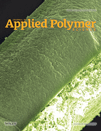Synthesis and properties of highly hydrophilic waterborne polyurethane-ureas containing various hardener content for waterproof breathable fabrics
Abstract
As part of an ongoing search for highly hydrophilic waterborne polyurethanes for waterproof breathable fabrics, a waterborne polyurethane [waterborne polyurethane-ureas (WBPU): P70, the number indicates the poly(ethylene glycol) (PEG) content] dispersion was synthesized from PEG (70 wt %) and dimethylol propionic acid (14 mol %) as the hydrophilic/ionic components, 4,4′-diisocyanato dicyclohexylmethane as a diisocyanate, ethylenediamine as a chain extender, and aliphatic tri-isocyanate as a hardener. To determine the best highly hydrophilic WBPU coatings for waterproof breathable fabrics, this study focused on the effect of the hardener content(0–1.2 wt %) in the WBPU P70 sample on the dynamic thermal mechanical properties, contact angle/surface energy, water swelling, water insolubility, and water vapor transmission rate (WVTR). The contact angle, water swelling, glass transition temperature, modulus, and strength increased with increasing hardener content, whereas the surface energy, water insolubility, and WVTR decreased. Sample P70/0.5 (cured sample containing 0.5 wt % of hardener) showed relatively good dimensional stability in water (high water insolubility), strong hydrophilicity (low-water contact angle/high-surface energy/high water absorption), and a high WVTR, highlighting its promising applications in waterproof breathable fabrics. © 2012 Wiley Periodicals, Inc. J. Appl. Polym. Sci., 2013




